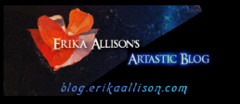Erika Allison's Artastic Blog
Breaking the rules… or not
Archive for the ‘Inspiration’ Category
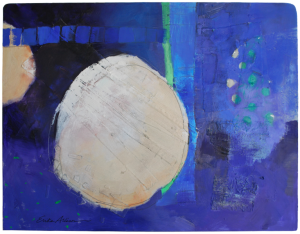
Executive Acres, oil / mixed media on panel - Dimensions: 24 7/8" x 32" x 1 3/4"
I usually don’t know what a work is about until I’m done with it and have it titled. I concentrate on design, composition, color, texture. I view it in all directions. I turn it upside, sideways and back up again, checking to see that I have a good composition. I feel that if one has a good composition the painting will work in any direction. Of course, I eventually have to settle on a direction that I think works best – or that I like the best. Then, I’ll start studying the painting to see what I “see” in it. Abstract work invites the viewer (including the artist) to see what he/she sees in it. Different viewers can see different things. Eventually, something will hit me, a title will come to mind and I’ll know I’m finished.
In this painting I felt like I was seeing outer space. Maybe planets, asteroids, the unknown. And, there’s all this talk about space travel, the new frontier, etc. Private companies are talking about trips into space. And, of course,only the very wealthy will be able to afford this kind of adventure. I’m thinking maybe a home on a new planet takes the place of the big house on the hill. But, then, you may see something altogether different. One of my artist friends sees a moon pie! She’s from the south, in case you couldn’t guess!
This original oil/mixed media painting can be seen at R Space Studio in The Arts Factory, 107 E. Charleston Blvd, Ste. 125, Las Vegas NV through February.
If you’re going to paint in a series you must know what it is that you’re painting about. You know where you’re going. That’s counter to my usual method of working. I usually don’t know what a work is about until I’m finished and it’s titled. When I come up with a title, everything falls into place and the meaning reveals itself to me.
I do have one series that I started several years ago and I keep adding to it when I’m moved to do so. I didn’t start out with series in mind. That idea came to me after I’d completed the first one and titled it. My “Twelve” series now has six paintings in it. I don’t know how many will ultimately end up there. The possibilities are endless. I like that!
My latest painting in the series is “Twelve and Twelve More”, a 10″x10″x1 5/8″ oil/mixed media painting on panel. It’s actually a variation on the theme of “twelve” because it actually contains twenty-four! It has twelve circles (the original premise), but also has twelve bars. I thought that was a fun variation.

"Twelve and Twelve More" - oil/mixed media on panel, 10"x10"x1 5/8"
Back to the beginning: I painted a 16″x16″x1 5/8″ painting containing twelve circles. The challenge was to make it interesting. The inspiration was a package of paper towels in the studio. In addition, I chose a complementary color scheme of red and green. So, I think I had a real challenge there! After I finished it and titled it (clever title, eh?) I thought I could paint this subject endlessly and have interesting variations every time. That’s how this series got started – with twelve circles. Most have twelve circles. One painting I decided that the “twelve” didn’t necessarily have to be circles, so I used a few squarish shapes. I will say that I think that one is the weakest of the series.

"Twelve" - oil/mixed media on panel, 16"x16"x2"
I really enjoy working on this series. I find it challenging. I’m taking a simple premise and painting it over and over again – and expecting the results to be unique and exciting every time.
I have a funny anecdote about my second attempt to add to my new idea of painting a series. I went from the smallish 16″x16″ to a large 60″x48″. I really like working large. My color scheme challenge was to use monochromatic scheme with yellow. Yikes! High key painting coming out! I finished it, thinking I had a ready-made title “Twelve.2″ I was about to write that on the back when I realized I had actually painted sixteen circles! Oh, no! Now, what? Obviously, I had to come up with a different title, which took awhile. I had to do a lot of thinking and studying before coming up with “Evolution/Revolution”.
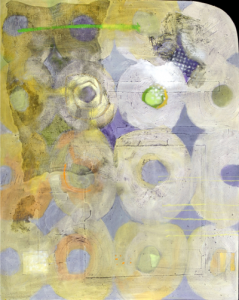
"Evolution/Revolution" - oil/mixed media on panel, 60"x48"x2"
I’m sure I’ll keep adding to this series. I have no idea when it will end, if ever…
That is the question. We all ask ourselves this question as we near the end of a work in progress. It’s usually not clear to us because there are so many options. We COULD add one more touch. OR – that one more touch could be what kills the work. Knowing when a work is done is critical. We have to be able to decide when the work is done.
Sometimes it’s clear to me that I’m done with a painting. It’s just obvious. It’s done! But, sometimes it’s not so easy to decide. Usually, if something is bothering me about a work, and I’m comfortable with the composition, it’s because it needs something more. I don’t always know right away what is needed. Sometimes I have to let a work sit around where I can view it and study it for awhile. Lots of options will come to me. That’s not really a good sign. Lots of options means I’m still undecided about what is needed.
This painting is a good example of a work that I studied for quite awhile before deciding what was needed. I really liked the work – the composition, the colors, the textures, the “feel” of the work. I liked the feeling of uncertainty about the bottom center area. That seemed to be what it was about. It kind of reminded me of a game board – chess, checkers, whatever. It was about deciding the next move. That’s where I got the title. BUT, it was missing something.

I finally decided that since I felt the work was about the “next move” that what was needed was a game piece – something to move! I didn’t want it to be too busy or obvious. It needed to visible, but not TOO important. A detailed, recognizable piece, such as a knight, would be too important…and draw the eye there as if it were the center of interest. So, I decided to just use an “X”. Then, I had to decide on a color and value. Again, I wanted it to be noticed but not dwelled upon.
I really like this work now. I think I came up with a good solution. There are always lots of options. Even after a work is done, you can look at it and wonder what if… But, I am usually content with my final choices. There’s always the next painting!

"Your Move" - oil/mixed media on panel, 18″x24″x1 5/8″
Did I fill the well? I certainly hope so! It seems that August came and went…and I didn’t produce much of anything. But, the artist’s life isn’t ONLY about producing. My last post was about filling the well. And, I refer to filling the well often. So, while I wasn’t doing a lot of painting, I was collecting, filing (mentally) and chewing on all kinds of thoughts and ideas. Ideas are percolating, fermenting, whatever you want to call it – in the subconscious, getting filed away to be pulled up for future use.
I had a busy month, even though I wasn’t producing. I celebrated a birthday. I took a vacation. And, I ventured to the arts district a number of times. Just hanging out with other artists and viewing other artists’ works in galleries or their studios, is inspirational. It gets the juices flowing. It reminds you of how many different ways there are to see the same things. And, the ways are endless. That leaves a lot of options for the artist to experiment with creative new ways to present familiar material. There is no end to the possibilities. You just can’t run out of ideas. There is really no excuse for not being able to come up with an idea!
I started a painting yesterday. I’m excited about it. I have covered the entire painting surface. But, I don’t yet know where I’m going with it. There are endless possibilities! I’m at the point now where I’ll study it for awhile, seeing various options. I envision some of the many possibilities as I look at the work in progress. I turn the work in all directions, for a couple of reasons. One reason is to check the composition. A good composition will work in any orientation. The other reason I turn it is that often I see something different – different meanings, possibilities – when a different view is presented. Eventually, I have to decide which way will be the top and where I’m going with it.
This is my painting in progress, after the first session. I’m excited about using an unusual painting surface. It was part of a fence intended for hiding stuff kept on a patio. The surface is a challenge in itself. Will it contribute to the painting – or detract from it? Being “different” is not enough to make a painting successful. It could just as easily detract from it. We shall see as I go along.

I have other surfaces waiting for me in the studio. And, more ideas than I seem to have time to fulfill. So – I guess the answer to “Did I fill the well?” is YES!
If you have thoughts on filling the well, feel free to comment. I welcome discussion.
What DOES “filling the well” mean? I’m guessing that most artists have some idea of what it means. It’s a huge and necessary part of the creative process. In order to say something, one has to have something to say! When you work and create and move on to the next project to work and create again – eventually that well can run dry. It needs time to re-fill. The well is what you draw on for ideas. You may consciously dig down in that well, looking for something. But, I think it’s usually a more subconscious thing. It’s not something you think about doing. It just happens. So, when that well is dry or nearly dry, time is needed while it re-fills. And, how does that happen? How does the well fill up again? All your life experiences are part of that well. Every vision, every thought, every encounter, every experience – contribute to filling the well.
So – time and living are the key requirements to filling the well. You need to take some time away from your studio and your creative process. You need to just “be”. Don’t be putting pressure on yourself to come up with ideas for your next creation. There will be plenty of ideas in due time. Your experiences and visions and subconscious thoughts are always pouring into that bottomless well. Even your daydreaming contributes. But, let it all be subconscious. Try to consider yourself “on vacation” from your art. You’re NOT, really. You’re never on vacation from being an artist. It’s who you are. But, TRY to just let your artist lie fallow for awhile. That is when seeds are being sown, ideas are percolating… And, soon enough, you’ll be heading into the studio again, ideas flowing, more than you think you have time to even work on. As if by magic, new ideas appear on your canvas, or whatever ground you work on. It’s an ongoing cycle. Take from the well…refill the well…
Do you have thoughts on filling the well? I’d love to hear from you on how it fits into your creative process.
I love texture! It’s an element that I think adds lots of interest to my work. I start with texture right from the beginning with the gesso. I apply the gesso with a cheap bristle brush and slather it on every which way, which leaves brush strokes that overlap. I don’t try to smooth it out or lay it on all in one direction. I’m looking for spontaneous strokes with lots of variety. If I were doing a portrait or landscape, this would be disastrous. I’d want to apply the gesso “properly” in a nice even coating, with no brush strokes showing. I’d sand between the two or three coats of gesso before starting my painting. BUT, I’m bucking tradition with my abstract mixed media work. I’m experimenting. I’m looking for new and different ways to work. I’m watching how my different materials react with each other. And, I’m looking for rich texture in the end. It’s reasonable, then, to START with texture.
There are many ways to achieve texture. Preparation of the painting surface is the place to start. I usually adhere different materials to the surface, experimenting with achieving different results. Then, there’s the application of the paint. Oils can be applied in a thick impasto, leaving raised areas where it’s the thickest. Materials can be “added” to the wet surface, as in throwing sand on it. There’s room for experimentation along the way. One thing I do consider is that my materials are archival. That sometimes leaves out interesting things I’d like to try. A lot of materials that would seem to make for interesting collage are really not at all archival. Newsprint doesn’t last long, nor do a lot of commercial printing inks that you’d find in newspaper or magazine pages.
Found objects can be attached to a painting during the process of creating the work – or after it’s finished. I love finding old, worn metal objects, rich with patina. There’s no end to the possibilities of texture in found objects. Pieces of screen or found jewelry components or hardware can all add interest. Or – you can create what is needed to meet your specific needs.

One method of creating texture is possibly overlooked. And, that is visual texture. Spray paint sprayed through a stencil or mask would be an example of what I’m talking about. The paint isn’t actually textural. It’s not raised. But, VISUALLY, it’s textural. And, that creates variety. Variety is always good. Too much of a good thing can be boring. Introducing a different approach or method will break up the monotony of too much of the same old thing. Stamping is another example of using visual texture. Some of my found objects have served me better as stamps than additions. And, of course, there’s dragging textural tools through the wet paint, creating grooves and furrows and scraping paint off to reveal colors beneath.

12.2
oil/mixed media on panel
12″x12″x2″
I’m guessing that you can come up with many other ideas on how to achieve texture. In art, the possibilities are endless. That’s the fun of it, the challenge…to find new ways.
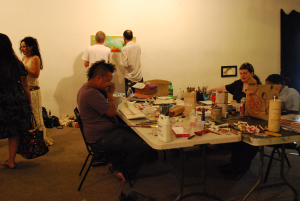
Paint-ins seem to be becoming “the thing” in the Las Vegas arts community. We had an outdoor group painting session in late spring. Now, there’s a regular “Third Friday” paint-in at Place Gallery, organized and hosted by Gina Quaranto. There is a nice, large area that works well for many artists to gather and work. Many mediums and styles were represented. There was painting in different media, sculpting, and a number of artists were working on their skate decks for LVSK8IV The Skate Deck Art Show
Creativity fills the air. You can breathe it in and use it. Artists are lost in what they are creating. And, then, they may be wandering around checking out what other artists are doing. I think the camaraderie is good for all. An arts community is what keeps a lot, if not all, of us going. We get support and encouragement, which is always needed. We build friendships. We try to give back in the ways that we can.
It takes some effort to haul all the needed supplies for painting somewhere other than your own studio. But, it can be worth it. Group painting offers some things we don’t get alone, holed up in our studios, which is our natural habitat. Aside from the camaraderie, you also get some publicity of sorts. It may just be word-of-mouth, someone who stopped in to watch mentioning they’d watched you paint. Or, it may be a possible collector who has seen your work on exhibit, who now gets to see you working. You’d be surprised how many people are fascinated by seeing an artist at work. Keep in mind that this is totally foreign to most people who are not artists. It may seem humdrum and everyday to you because that IS your life. You do it almost by rote. But, to the layman it may be magic. And, don’t forget, collectors and all buyers are buying a piece of the artist. Meeting you, seeing you in action, talking to you about your work or your methods, all provide fodder for the collector’s interesting story for his friends. Also, connecting with the other artists can be worthwhile beyond just the friendship and camaraderie. The artists here in Vegas are generous with their support of each other. Your name might come up when there’s an exhibition opportunity. And, last, but not least – it’s good to get out of your studio and participate in life! You need ideas for your work, life experiences! You need to fill the well!
Here is my painting after the session at Third Friday Paint-In. I will work on it more in my studio and post a picture when it’s completed.

Have you painted with a group? Do you enjoy it? What benefits or pitfalls do you find in painting with others present?
I have several paintings in the works right now. I have two that I started awhile back, but haven’t put the finishing touches on yet. The problem seems to be that I don’t know just where I want to go with them yet. I study them every time I go into the studio. I rotate them so I can view them from all possible angles. One of these times a solution will become clear to me… and I’ll proceed.
I also have two paintings that I started last Saturday at our First Annual Outdoor Paint-In. I really like the starts I got on both. I’m kind of amazed about that. It’s a bit of a pain to haul all the supplies needed for oil painting to an outdoor location. If I were a plein air painter I’d have a french easel and no complaints. But, I’m a studio painter. I like all the comforts of my studio. And, I don’t really need to view subject matter since I’m an abstract painter. Enough of that. The camaraderie is worth the effort. It’s interesting to see other artists at work. And, it was fun seeing people trying to figure out what was going on! At any rate, I got two good starts. And, this morning I worked on one of the paintings. I still like it. I’m not quite sure where I’m going with it. But, that seems to be how I work. For now, it’s time to leave it alone for awhile.
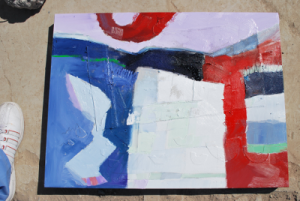
After first session of painting

After session 2 in the studio – on the easel
The second painting from last week is still waiting for me. I could’ve gone right from where I left off on painting number one and started working on the second one. But, sometimes it’s better to just concentrate on one until it’s finished. There’s no rule of thumb on that. It’s my call. I think by not working on both today there’s a better chance of keeping them very individual. Sometimes I get in a groove and what I do on one painting gets carried over to the next. I don’t want to be an assembly line. I want each painting to have it’s chance of shining on its own.

Painting 2, on the easel
So – this challenge is for another day. There are plenty of possibilities, as always…
"History in the Making"
Tension in a painting can be interesting, as well as useful. I like tension in a painting. It can be used by the artist to direct the viewer’s eye where he/she wants it to go. An example of what the artist does NOT want to do is direct the viewer’s eye OUT of the painting. For instance, a profile portrait placed too close to the edge where the sitter is looking “out” – actually directs the viewer’s eye out of the painting. Never to return. Viewer moves on to next artwork. You’ve lost your viewer!
In my painting, “Every Day Is History in the Making” it’s pretty easy to see the tension. I was aware of it while I was working on the piece. I decided I liked it, so I kept it and used it to my advantage. It’s easy to spot the darkest dark and the lightest light. That is my center of interest, which I established right away in the painting. At some point, while studying my progress, I decided that the lightest light was TOO harsh. It needed softening. I felt that additional paint and/or brush strokes was not the answer. I didn’t want to muck it up, so to speak. So, I chose to use silver spray paint. It softened the hard edges that were bothering me. It kept it light (silver is very reflective).
The next thing I noticed while studying my progress was that there was a large dark area to the right that was competing with my darkest dark. It had some other marks in it to break it up a bit. And, it was slightly gradated from solid dark to a little less dark. But, that was splitting hairs. The fact is that it was really competing. My eye kept being pulled from the center of interest (lightest light/darkest dark) to the very dark shape at the right…and, then, back again. I decided I really liked that. I liked the tension. I also liked that it kept the viewer’s eye in the picture. I wasn’t leading the eye out of the picture and away from my art. Mission accomplished!
"Don't Suck Me In"
Another good example of tension can be seen in my recently completed work, “Don’t Suck Me In”. I started that piece with a challenge to myself. I placed my lightest light and darkest dark as my center of interest. Both are quite small. The challenge was to see if it would hold up as the center of interest even though it was small. I did also use red right next to it sort of as an insurance policy. Red will always catch the eye.
If you followed my previous posts about the evolution of “Don’t Suck Me In”, you know that the big sequins were the last addition to the work. And, they really create some tension. It’s pretty hard not to catch the eye with big, silvery, glimmering sequins blowing in the wind! Yet, my intended center of interest is over to the right where the little bitty white and black areas (and some red) are. Again, I find that my eye goes back and forth from the intended center of interest to the sequins. This is great! The whole meaning of the work is tied up in tension. If you noticed the snakeskin under the paint near the center of interest…tension! Then, the title suggests getting sucked in. Sucked in to what? Well, that’s up to you. But, the words that are written along the right sight suggest some possibilities. As long as the eye is kept inside the picture plane, I feel it has been successful. The more time the viewer is kept inside the painting, the more time he has to find the more nuanced areas that may suggest more nuanced meaning.
So, now you know some things I think about while working. I hope you found it interesting. Feel free to give me some feedback. I know how the artist thinks. I’m very curious about what the viewer sees and thinks. What catches and holds YOUR attention?
After studying “Don’t Suck Me In” for awhile, I decided it needed some retouch varnish before making any changes. It had a dead appearance and needed brightening up a bit. That was a good start. Now, I could proceed with actual changes or additions, whatever the case may be. I decided additions were needed. I zeroed in on what was supposed to be my center of interest. I used some white spray paint, silver spray paint and white oilstick. As you can see, I added some writing: “Open for business”.
I already had a plan in mind for the coup de grace. But, I’d have to wait for the paint to dry before proceeding. That was hard because I really wanted to charge in and finish it up and stand back and gloat about adding the perfect final touches. White paint can take a long time to dry, so patience was required. The image here shows where I had to leave off. It may not look that much more exciting than before I started. You may even wonder if it helped at all. You may wonder if I’m crazy. Why would she do THAT?
You’ll have to hold your breath til the final installment.
“Don’t Suck Me In”
….in progress


